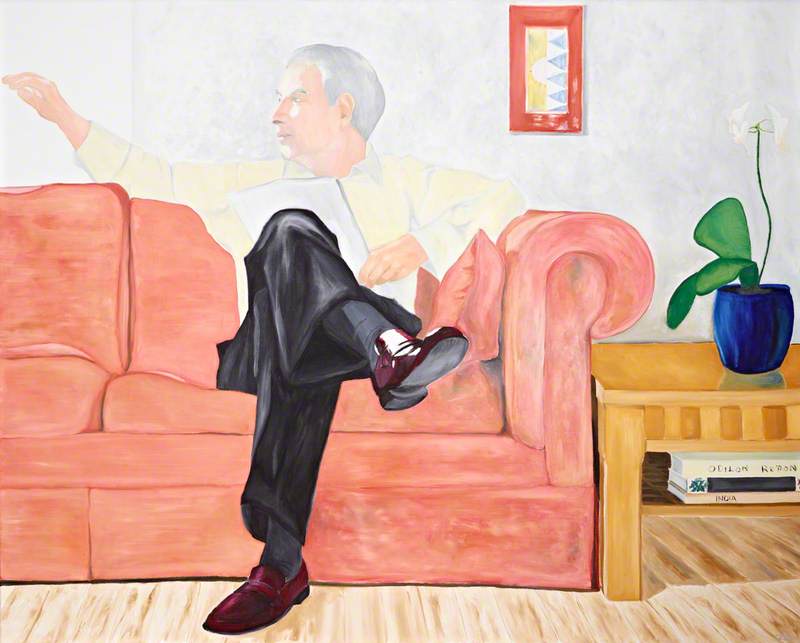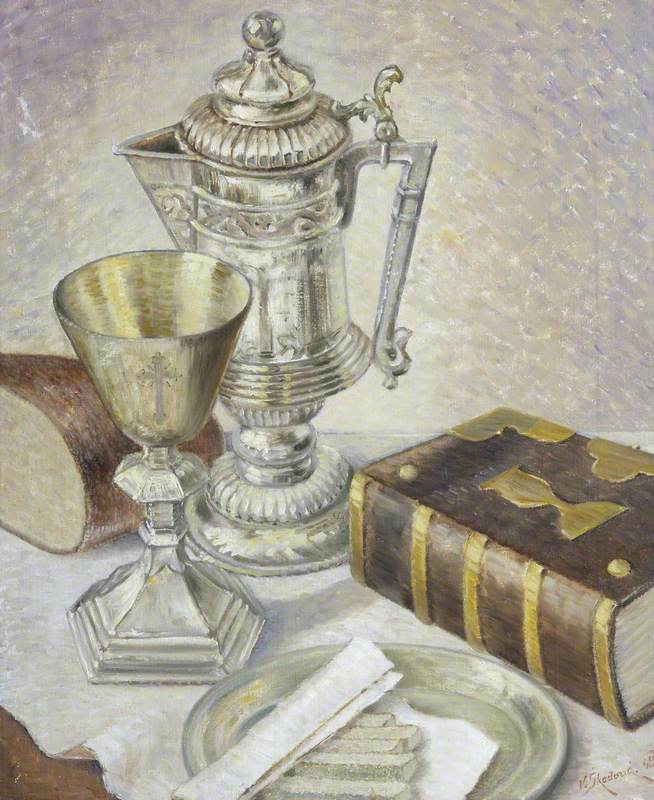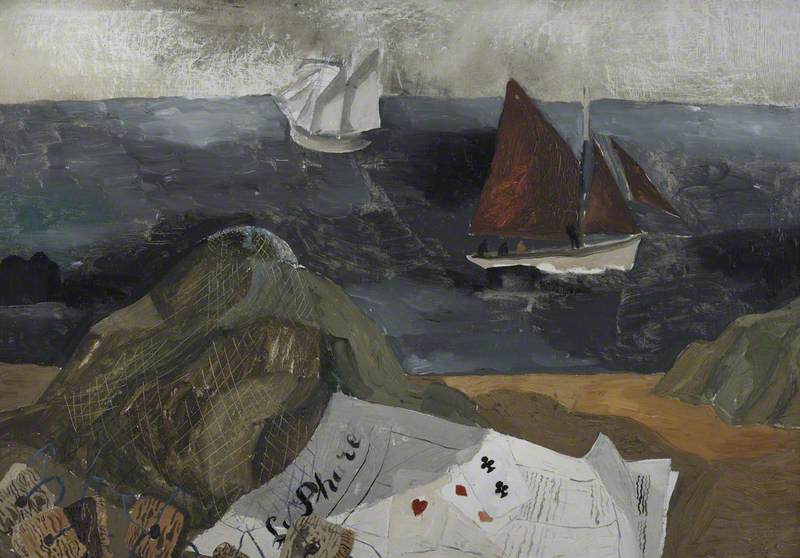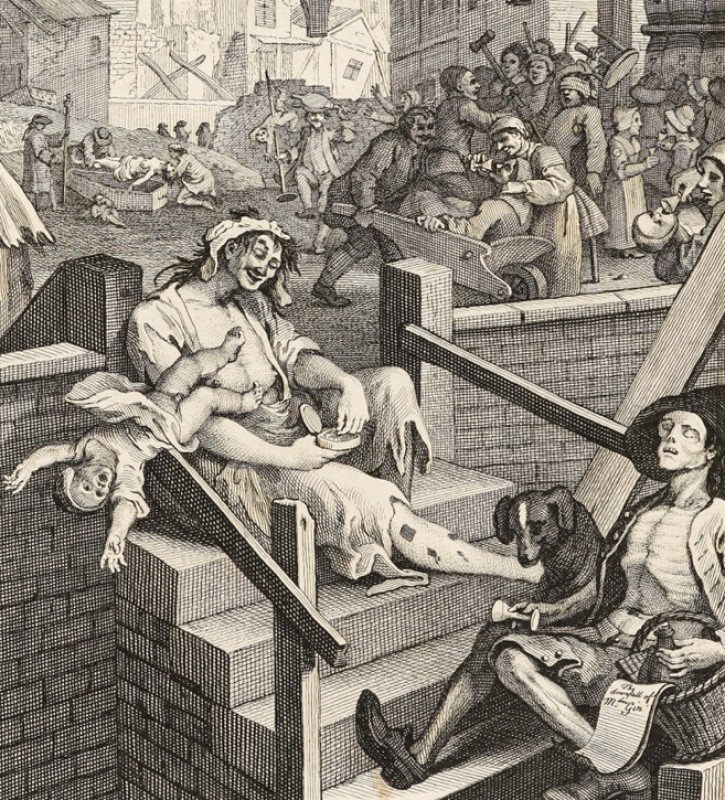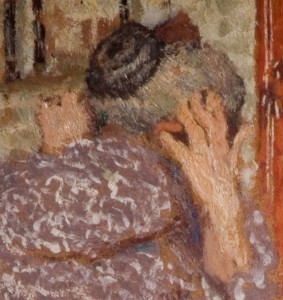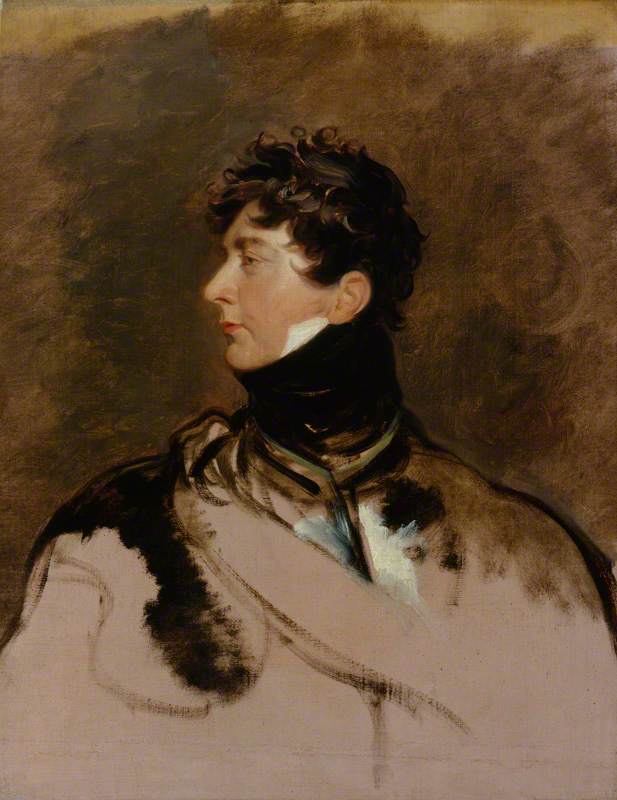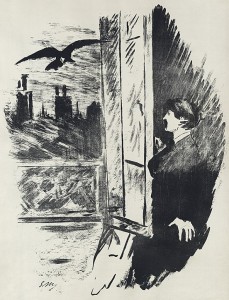When viewing art, the eye has a tendency to identify generalised themes and bask in bold forms and bright colours. Careering through galleries, museums and fairs, the knowing winks, and amusing nods hidden away in minutiae can be missed. Hidden as they may be, they are still in plain sight, and it takes only a bit of curiosity to find them.
Take a cursory glance at Portrait of Gordon Johnson and the eye absorbs the sumptuous pinkish sofa and perhaps the figure that sinks into its folds. What certainly goes unnoticed, even on closer inspection, are the three books nuzzled under the coffee table top. Here, at the bottom of the pile we have a nod to India.
Whilst this might be easily missed, it is arguably the most revealing part of the painting. Books in artworks, as we see across a number of works on the Art UK website, are often symbolic. They can be pulled out and read for their deeper meaning.
This book, with India inscribed along its spine, is not incidental. The artist is deliberate and uses this object to hint at the sitter's character. If you assumed the man studied India then you would be right. For this is Gordon Johnson, President of the Royal Asiatic Society and past Director of the Centre for South Asian Studies, Cambridge (1983–2001).
Looking across the portrait and scanning his hands we might even decide he holds a book manuscript. This could be the latest addition to his impressive succession of publications about colonial India or a piece he is editing. He is obviously contemplating the text carefully, his hand poignantly outstretched.
While this is a bona fide man of books other artworks in the collection certainly use dictionaries and treaties to unfairly enhance a sitter's intellect. The examples of men parading their library shelves and propped up by piles of books are endless. These books are part of an intricately planned performance. As the Wellcome Library image, A Man Holding an Anatomy Book with an Engraving of a Woman Showing Her Viscera shows, these are books of bravado.
A Man Holding an Anatomy Book with an Engraving of a Woman Showing Her Viscera
18th C
unknown artist 
Just as current trends for bookshelf wallpaper, carefully 'curated' boutique hotel book shelves, bibliotherapists at the School of Life and the swing of a Daunt Bookshop bag show; books have cultural capital and cachet.
But beware: books can also inform slight and satire. William Hogarth was a master of inserting literary references to formulate his moral critique. His self-styled modern moral subjects unanimously contained snippets of text. Across these works specific texts are included to fulfil the artist's aims to create works which would, 'both entertain and improve the mind, bid fair to be of the greatest utility'.
In the plate Expires while the Doctors are Disputing from the series A Harlot's Progress (1732), a loose leaf advertising an 'anodyne necklace' surrounded by smashed porcelain references the misguided yet popular quackery of the time.
A nice death scene by Hogarth to brighten the end of the week - A Harlot’s Progress V
— Hogarth's Progress (@HogarthProgress) March 23, 2018
Moll is dying of Venereal disease while two quack doctors argue over their cures...#williamhogarth #18thcentury #fridayfeeling pic.twitter.com/dq0qwHY3cW
Throughout Hogarth's famous series A Rake's Progress we see open books being read or surreptitiously placed in the far right corners of the series.
A Rake's Progress: 1 – The Rake Taking Possession of the Estate
1734
William Hogarth (1697–1764) 
Deeds are on show in The Rake Taking Possession of the Estate, the personalised sheet music with the initials F. H. in The Rake's Levee leads us to understand that this is Frederick Handel whilst the wedding vows sitting opened out in the vicar's hands in the fifth canvas point to the Rake's entirely pragmatic investment in his union with an unsavoury heiress.
A Rake's Progress: 5 – The Rake Marrying an Old Woman
1734
William Hogarth (1697–1764) 
Where this use of a book is most pointed is in Marriage A-la-Mode: 4, The Toilette. Here wedged into the back of a seductive red brocade chair, again in the right hand corner of the work is a piece of erotic fiction. Whilst visually subtle this is a huge clue to the painting's narrative.
Marriage A-la-Mode: 4, The Toilette
about 1743
William Hogarth (1697–1764) 
This book reveals an affair that has been building up from the first scene of this epic sextet. The pages beneath the lawyer Silvertongue's bottom are Le Sopha (The Sofa: A Moral Tale), a fashionable libertine novel written by a French author, Claude Prosper Jolyot de Crébillon in 1742.
This choice of literature carries the painting. The text; a tale of morality, passion, illicit liaisons and commentary on tolerated adultery clearly notes the sexual tension between these two characters. The plate which follows, The Bagnio confirms all the suspicion piqued by this text. It shows the remnants of an extra-marital tryst.
Hogarth was clearly associated with books. If we look in the foreground of Edward Thomas Ward's painting, Hogarth's Studio there is a suitably expensive leather bound volume.
Whilst on first impression is part of the setting for the impressive portrait of Captain Thomas Coram, hung in the background, this cluster of items works harder.
If we consider the date of this piece, some 99 years after Hogarth's death, this image is a memorial to the artist. Reading this studio impression like a portrait, the book is symbolic. It tells us more about Hogarth and suggests how he socially positioned himself. The book-globe trope hints that had an inflated sense of self. He perhaps thought of himself on a par with Coram, an immense philanthropist who established The Foundling Hospital in Bloomsbury.
Panning out from these wry and celebratory insertions books can also be artworks in themselves. During the inter war period Russian Futuristists such as Natalia Goncharova created uniquely handcut collaged book editions as aesthetic manifestos. Ed Ruscha notably revisited the genre when he created Twentysix Gasoline Stations (1963) and more recently we see the work of Sam Knowles, The Great Enterprise (2011), which is a pile of aged books skewered like a kebab.
A similar pulling apart of books is seen in Jeff Instone's work Footnote 3.
Here the artist performs a paper dissection, cuts open the pages and splays out a series of angered thick pencil scrawls. By virtue of being placed upside down these are made illegible. The piece plays with our expectations of a book.
If this muddies the idea of a book being a tool of communication other pieces in the UK's collection show that some texts stand alone. The strength of the Penguin Classics series is beautifully suggested by William George Gillies Yellow Jasmine.
Here no writing, just colour and form note the iconic status of this series. In a similar vein, Skodove's Still Life of Silverware and a Book requires no detail or introduction. Richly bound with brass clasps this is quite clearly a treasured sacred text.
Magnifying micro-details allows us to read art in new ways. Using books to look at art shows that they can transmit information, change perspectives, form a critique or confirm the status quo. Whether specific texts are noted, as seen in Hogarth's work, or a book is the art in itself, throughout Art UK the collections perform and create new chapters in the interpretation of art.
Cleo Roberts, Visiting Research Associate at Wolfson College, University of Cambridge
